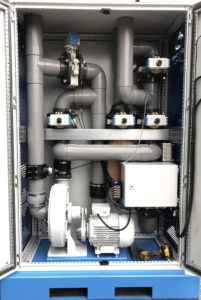CO2 adsorbers for fruit and vegetable storage have cycles that consist of 2 phases. During the adsorption, CO2 is removed from a cold store with the aim of maintaining the target value. During regeneration, the absorbent is cleaned and prepared for the next adsorption phase.
Unfortunately, optimal adsorption and regeneration times fluctuate widely. They depend on the CO2 value in the cold store (which in turn depends on the product), the respiration rate, and the type of adsorber. Cycle times largely determine the capacity of an adsorber. It is clear that the more cycles a machine completes per day, the more CO2 is removed. So you would expect a continuous optimization of phase times, but in reality they are set as a fixed value. This often happens once and after that it is no longer looked at.
Activated carbon becomes saturated at a certain point and after that adsorbing is pointless. In fact, only air is circulated from that point on. It is not the case that CO2 no longer binds, but the efficiency of this is so low that it does not yield any overall profit. The other way around is also ineffective: a too early start of the regeneration before full saturation has been reached. By continuously determining the optimal phase times, the efficiency of a machine can thus be greatly improved.
The same applies to regeneration. Too short regeneration means that the next adsorption phase will not be effective, especially if a low CO2 value has to be maintained in a cold store, such as with pears. Regenerating for too long is ineffective as it only takes time and allows fewer cycles per day.
Blue Atmosphere has a unique way of solving this: an internal CO2 sensor. During adsorption, it measures to what extent CO2 passes through the activated carbon , and during regeneration how much CO2 is (still) drawn from the activated carbon. A software algorithm automatically determines the optimal phase times. This is a continuous process.
In addition to phase time optimization, there are three other elements that make our adsorbers unique:
- An improvement of the air flow through the adsorber.
- The use of a stronger direct drive fan that prevents the pressure from collapsing during adsorption. (Blog April 15, 2021)
- Software that enables CO2 adsorption up to 3 cold stores (each with a higher CO2 value) before regeneration takes place. The software ‘searches’ which cold stores are suitable for this.
The above unique properties lead to a capacity improvement of 50-75%.
